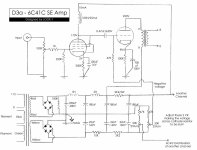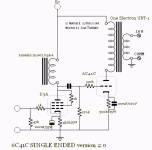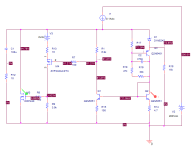I'm contemplating doing a single-ended amplifier using the 6S41S triode, perhaps with a depletion-mode mosfet front end. I'm thinking of using the Toroidy 600 ohm primary toroidal single-ended iron for the output, and a discrete shunt regulator to bias the cathode (damped/bypassed by a capacitor of suitable voltage rating). I would run the front stage off the output of a Plitron medical isolation transformer I have a couple of, and the 200V for the output stage would be generated with a discrete self-driven buck regulator with suitable filtering. I need to rummage around and actually find my 6S41S stash, and I think I have a couple of suitable sockets (the tube is a little weird, and takes a strange 7-pin socket).
I have some big (BIG!) 1250 ohm transformers that I bought a while ago from Triode Electronics. They are almost too physically large for the job, but I guess I can prop up the chassis somehow to take the weight. I also have a pair of One Electron UBT-1 transformers with a 1.7k primary impedance. They are also rated for enough current to handle the 100 mA bias I plan to use for the 6S41S. They are much more petite than the 1250 ohm monsters. The UBT-1s are kinda what I had in mind when I first had the idea to try this project. So, maybe not as much power output with 1.7k than with 1200, but I'm looking for enough power to tickle the Klipsch Tangent speakers I have in my living room. . 20W/side of class A power gives me enough volume with those speakers to run me out of the room.
Last edited:
IHMO ,In any case for the best sonics make the amplifier simple and consist of only two active stages, the first stage to be a voltage amplifier and also a driver stage for the output power stage with a 6C41C tube, both stages to operate with automatic bias and to be RC coupled.
I would likely be using a depletion mode mosfet for the front end rather than the D3a - no choke loading, either. Feedback would include the output transformer, as I got away with that on my last project using the UBT-1
That project is detailed in this thread:
That project is detailed in this thread:
Attached is a photo of the first proto of an SE amplifier( the "SiC Puppy") using the Semisouth 085 silicon carbide JFET in the output stage. The front end uses the Supertex DN2540N5 depletion mode mosfet. I choose the Semisouth part over the IXYS depletion mode parts due to the extra headroom afforded by the 1200V rating, allowing me to choose B+ voltages with a bit more freedom. The circuit (to follow) is set up just as if the two parts were pentodes, with partial feedback from the output drain to the input drain, plus a limited amount of global feedback (disconnected at firtst. I used...
Here's the discrete shunt regulator I'll be using to bias the 6C41C cathodes. R17 may likely need to include a trimmer, as I have heard that in Russki tubes there is a fair amount of variability from unit to unit. This is likely to be the case for the 6C41C, as it is a tube intended for VR use with low internal resistance.
Attachments
Last edited:
Actually, the One Electron UBT-1 is 1.6k rather than 1.7k, so perhaps I can squeeze out a teensy bit more power.
On the shunt regulator, FET M3 will likely need a generous heat spreader - I have some thick aluminum angle stock in mind. I'll likely be putting the depletion mode input stage and the shunt regulators (one for each output tube) on one board, with the interstage coupling cap and grid to ground resistor also included on the board. Output will likely need a Zobel network to make sure the loop gain goes below 0 dB and stays there.. Feedback will be to an appropriate point on the depletion mode MOSFET cathode bias network. I'm thinking of also loading the rectifier bridge and filter cap for the rectified output of the isolation transformer on the board with the input MOSFET and the shunt regulator, so it can be next to the depletion mode MOSFET input stage. Ill probably use UF5406 to rectify the 240V output of the isolation transformer. Also, in the mix, the bypass cap for the 200V rail for the 6C41C and the Output transformer.
Also, can't forget the discrete buck regulator, which will need its own board.
This project will come together in bits and pieces as I get around to it. It'll likely need a fairly large chassis to hold all the various bits and pieces., probably 3" tall.
Also, can't forget the discrete buck regulator, which will need its own board.
This project will come together in bits and pieces as I get around to it. It'll likely need a fairly large chassis to hold all the various bits and pieces., probably 3" tall.
Last edited:
- Home
- Amplifiers
- Tubes / Valves
- 6S41S Single-Ended Amplifier


